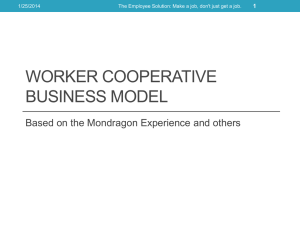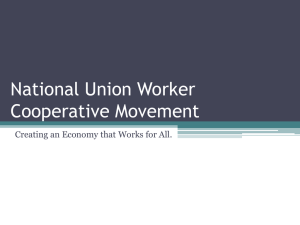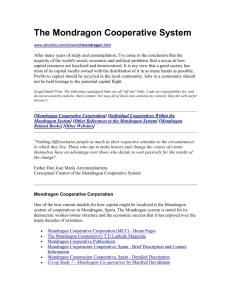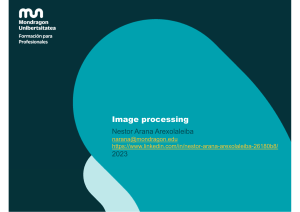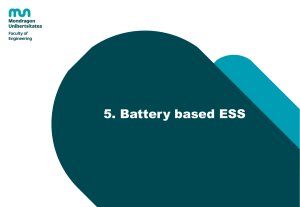Transforming Basque Manufacturing Companies Through Service
advertisement
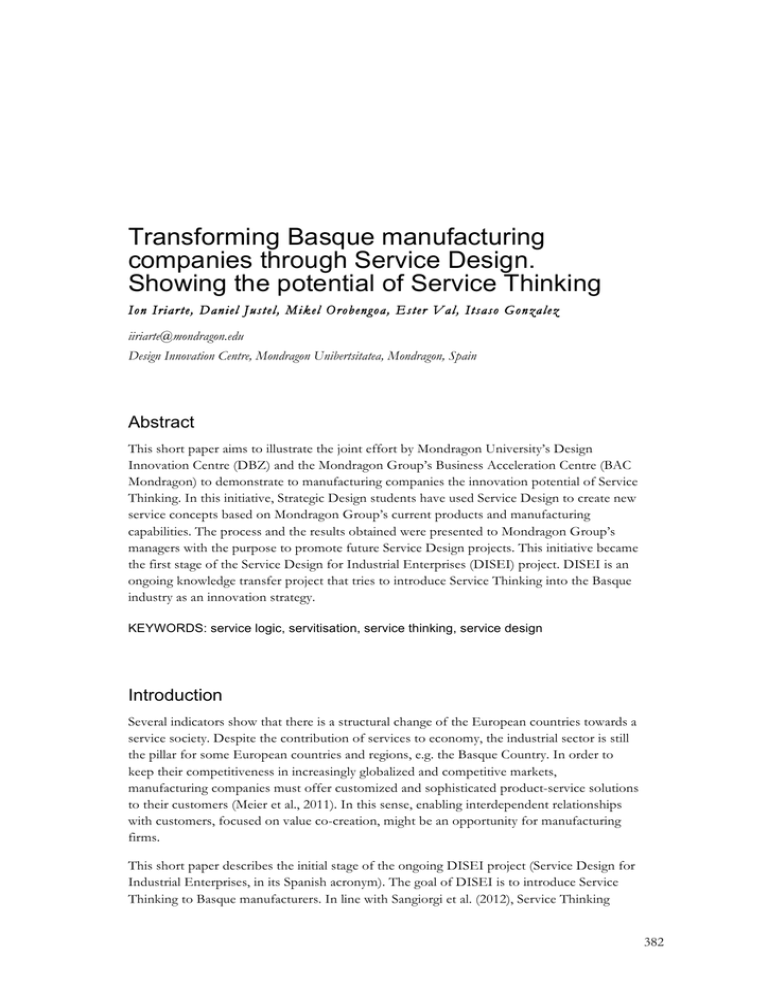
Transforming Basque manufacturing companies through Service Design. Showing the potential of Service Thinking Ion Iriarte, Daniel Justel, Mikel Orobengoa, Ester Val, Itsaso Gonzalez iiriarte@mondragon.edu Design Innovation Centre, Mondragon Unibertsitatea, Mondragon, Spain Abstract This short paper aims to illustrate the joint effort by Mondragon University’s Design Innovation Centre (DBZ) and the Mondragon Group’s Business Acceleration Centre (BAC Mondragon) to demonstrate to manufacturing companies the innovation potential of Service Thinking. In this initiative, Strategic Design students have used Service Design to create new service concepts based on Mondragon Group’s current products and manufacturing capabilities. The process and the results obtained were presented to Mondragon Group’s managers with the purpose to promote future Service Design projects. This initiative became the first stage of the Service Design for Industrial Enterprises (DISEI) project. DISEI is an ongoing knowledge transfer project that tries to introduce Service Thinking into the Basque industry as an innovation strategy. KEYWORDS: service logic, servitisation, service thinking, service design Introduction Several indicators show that there is a structural change of the European countries towards a service society. Despite the contribution of services to economy, the industrial sector is still the pillar for some European countries and regions, e.g. the Basque Country. In order to keep their competitiveness in increasingly globalized and competitive markets, manufacturing companies must offer customized and sophisticated product-service solutions to their customers (Meier et al., 2011). In this sense, enabling interdependent relationships with customers, focused on value co-creation, might be an opportunity for manufacturing firms. This short paper describes the initial stage of the ongoing DISEI project (Service Design for Industrial Enterprises, in its Spanish acronym). The goal of DISEI is to introduce Service Thinking to Basque manufacturers. In line with Sangiorgi et al. (2012), Service Thinking 382 could be understood as a framework for innovation that has its roots in a new way of thinking about value (Service Logic), that affects the way products and services are conceived (Service Design). In this first stage, Service Thinking potential is shown to manufacturing companies’ managers in order to promote future Service Design projects. Servitisation and Service Thinking The importance of services in the industrial sector has grown remarkably during the last years (Neely et al., 2011). Kujala et al. (2013) summarise the benefits of services for industry identified from literature into five different perspectives: (i) Strategic benefits, based on differentiation and the creation of entry barriers for competitors, (ii) Financial benefits, based on the stabilization and the increasing of revenues, (iii) Marketing and Sales benefits, based on the increasing of the familiarity, credibility and trust with the customer, (iv) Learning and Innovation benefits, based on the access to useful information about the client, and (v) Implementation Efficiency benefits, based on improving delivery efficiency through information exchange and cooperation. However, the adoption of more ‘servitised’ perspectives brings significant corporate challenges for manufacturing companies. These challenges are related to customer relationships, pricing and financial flows uncertainties, organisational and cultural shifts, changes on design, development and delivery processes, etc. (Baines et al., 2008; Meier et al., 2010). In this sense, the product-service transition phenomenon has been studied by several authors (e.g. Gebauer & Friendli, 2005; Oliva & Kallenberg, 2003) as well as value creation and co-creation processes through services (e.g. Payne et al., 2008; Vargo & Lusch, 2008). Nevertheless, it is necessary to underlain that according to Kowalkowski (2010) ‘servitisation’ and the transition from Goods Logic to Service Logic are two distinct change dimensions. The first reflects a strategic repositioning of the manufacturing firm in the market through a shift from selling products to selling services. The second reflects a new perspective on value creation, from value added to value co-creation. These transitions may or may not be parallel movements. Service Dominant Logic (Vargo & Lusch, 2008) can be considered as the theoretical paradigm of value creation transition and Service Thinking can be described as the potential driver for this transformation (Sangiorgi et al., 2012). So that, Kowalkowski’s (2010) original reasoning can be reframed as it is indicated in “Figure 1”: Service thinking and Product-Service transition. Figure 1 two distinct service transitions for manufacturing firms. This means, that for manufacturing companies, the implementation of Service Thinking as an innovation strategy may not necessarily mean a radical shift into a more ‘servitised’ 383 business models. Ergo manufacturing companies could use Service Design as an innovation methodology to reach market differentiation, searching for closer and more customized cocreated solutions, without causing a significant scroll in the product-service continuum. This implies, that in Service Thinking transition, some inherent financial risks and uncertainties of ‘servitisation’ processes could not be critical because the business model may not change significantly. However, manufacturing companies’ cultural barriers for the assumption of value co-creation frameworks are still to be considered. In this regard, one of the challenges for the adoption of Service Thinking in the industrial sector is enabling the cultural shift among managers, marketers, designers and engineers. The DISEI Project The aim of DISEI project is to introduce Service Thinking as an innovation strategy among Basque manufacturers in order to enable both ‘servitisation’ and Service Logic transitions. To do this, the project counts with the collaboration of Mondragon Group (the leading business group in the Basque Country) present in several industrial sectors. DISEI is thought as a knowledge transfer project conducted through case studies. Beckman & Barry’s (2007) innovation framework propose to embed innovation in organizations as a learning process. The authors frame their innovation process as one storytelling and re-telling divided in five steps: (i) Make me care, (ii) Show me something new, (iii) Tell me what’s missing, (iv) Show me opportunities and (v) Make it tangible. In this case, Beckman & Barry’s process has been reframed into three stages for DISEI’s specific purposes: (i) Show the potential of Service Thinking, (ii) Experiment with Service Design, and (iii) Implement Service Design. The process is illustrated in “Figure 2”. Figure 2. Stages for the introduction of Service Thinking in manufacturing companies. The goal of the first stage is to show the innovation potential of Service Thinking to manufacturing companies (Make me care and Show me something new), raising awareness on ‘design readiness’ (Bailey, 2012). This is carried out via demonstrations oriented to manufacturing firms' managers. These demonstrations illustrate conceptual human centred service solutions designed by Strategic Design students for each of their specific industrial companies. The second stage is focused on making industrial companies experiment with Service Design (Tell me what’s missing and Show me opportunities). This is carried out via Real Life Learning Labs, where teams of students under mentorship of lecturers and industry professionals work on real life assignments. The third stage is focused on the ServDes.2014 Fourth Service Design and Innovation conference 384 implementation of Service Design through the access of Strategic Design students to industrial companies. The idea is to implement the previously designed service concepts (Make it tangible). Students are integrated in the company staff, supported by company’s heads and university’s Service Design experts, to assure the sustainable embedding of Service Design, since the implementation of innovation in organizations often fails to achieve the expected results when it is delivered by an external agent (Mugan & Albury, 2003). DISEI is thought as a qualitative case study research and as a non-linear process, where the feedbacks of the performed cases enrich the following ones. The next section describes how the first stage has been carried out. First stage: showing the potential of Service Thinking Establishing participatory cooperation synergies between the Group’s companies is one of the continuous objectives of Mondragon. In this sense, BAC Mondragon has taken the initiative of materializing the Group’s intra-entrepreneurship strategies. In this task, one of the strategies for generating new business opportunities is to promote services based on the current installed manufacturing capabilities. The interests of BAC Mondragon suits with the purposes of DISEI project, so, a business-academic collaboration was launched where Strategic Design students used Service Design methods and tools for manufacturing companies. Students were asked to use Service Thinking principles (from value added to value cocreation, from units of output to processes, from individual actors to interconnected systems) and Service Design tools, to re-think manufacturing companies’ value propositions focusing on inter-cooperation between Mondragon Group’s companies. Based on this premises, students conducted an analysis of Mondragon’s products and manufacturing capabilities, and collated them with global and sectorial trends, and potential customers’ needs. Grounded on this analysis, students identified potential service opportunities. Then, based on these opportunities, new service concepts were created using Service Design tools. Initially, as the students were free to propose radical changes, it was expected that the service solutions would imply a ‘servitisation’ movement for the companies. Nevertheless, it was noticed that the solutions designed by the students, even if they are just concepts, could reach some specific market differentiation benefits without affecting significantly companies’ business models. In fact, the proposed concepts increase the familiarity with customers, enabling access to useful information and generating improvements in product design and delivery through information exchange, without significantly modifying cost infrastructures, main revenue channels and key resources. However, the customer experience was deeply influenced. The performances designed within the service concepts changed the interaction with customers from product centred to process and human centred frameworks. The service concepts, the design process and the Service Design tools used by the students were presented to Mondragon manufacturing companies’ 40 executive heads through a monographic workshop designed to: (i) show participants Service Design methods and tools via Service Design expert presentations, (ii) learn to think outside the conventional view of their specific business inspired by students’ service concepts, (iii) conceptualise new potential business opportunities based on the provided Service Design competences and examples, and (iv) sketch preliminary action plans for the realisation of future Service Design projects. 385 Conclusions The conceptual service propositions showed the innovation potential of Service Thinking for Mondragon Group’s manufacturing companies. In fact, Service Design projects in several sectors (machine-tool, automotive and construction industry) have been launched thanks to the good reception of the service concepts. Currently, these projects are being carried out by the students, and supported by university’s researchers. The success of this initiative is also due to the figure of BAC Mondragon, key promoter of new service opportunities inside the corporation. As it is told, DISEI is still in development, so the theoretical framework where it is grounded must be demonstrated with further case studies. However, the initial empirical experiments suggest that Service Design could be considered as a new methodology to guide manufacturing companies in Service Logic transition. In the same way, the preliminary results show, that also in industrial contexts, customer interaction could be conceived as a human centred value co-creation process without causing a significant scroll in the productservice continuum. References Bailey, S. G. (2012). Embedding service design: the long and the short of it. Service Design and Innovation Conference, ServDes2012. Retrieved from http://servdes.org/pdf/2012/bailey.pdf Baines, T. S, Lightfoot, H.W., Evans S., Neely, A., Greenugh, R., Peppard, J., Roy, R., Shehab, E., Braganza, A., & Ashutosh, T. (2007). State-of-the-art in product-service systems. Journal of Engineering Manufacture, 221(10), 1543-1552. doi: 10.1243/09544054JEM858 Beckman, S. L. & Barry, M. (2007). Innovation as a Learning Process: Embedding Design Thinking. California Review Management, 50(1), 25-56. Retrieved from http://cmr.berkeley.edu/ Gebauer, H., & Friedli, T. (2005). Behavioral implications of the transition process from products to services. The Journal of Business and Industrial Markenting, 20(2), 70-78. doi: 10.1108/08858620510583669 Kowalkowski, C. (2010). What does a service-dominant logic really mean for manufacturing firms?. CIRP Journal of Manufacturing Science and Technology, 3(4), 285-292. doi: 10.1016/j.cirpj.2011.01.003 Kujala J., Ahola, T. & Huikuri, S. (2013). Use of Services to Support the Business of a Project-Based Firm. International Journal of Project Management, 31(2), 177-189. doi: 1 0.1016/j.ijproman.2012.07.007 Meier, H., Roy, R., & Seliger, G. (2010). Industrial Product-Service Systems—IPS2. CIRP Annals - Manufacturing Technology, 59(2), 607-627. doi: 10.1016/j.cirp.2010.05.004 Meier, H., Völker, O. & Funke, B. (2011). Industrial Product-Service Systems (IPS2). The International Journal of Advanced Manufacturing Technology, 52(9-12), 1175-1191. doi: 10.1007/s00170-010-2764-6 Mulgan, G., & Albury, D. (2003). Innovation in the public sector. Strategy Unit, Cabinet Office, Retrieved from http://www.sba.oakland.edu/faculty/mathieson/mis524/resources/readings/innovation /innovation_in_the_public_sector.pdf Neely, A., Benedetinni, O., & Visnjic, I. (2011). The Servitization of Manufacturing: Further evidence. Proceedings of the 18th European Operations Management Association Conference, EuOMA 11. Retrieved from ServDes.2014 Fourth Service Design and Innovation conference 386 http://www.cambridgeservicealliance.org/uploads/downloadfiles/2011The%20servitization%20of%20manufacturing.pdf Oliva, R., & Kallenberg, R. (2003). Managing the transition from products to services. International Journal of Service Industry Management, 14(2) 160-172. doi: 10.1108/09564230310474138 Payne, A. F., Storbacka, K., & Frow, P. (2008). Managing the co-creation of value. Journal of the Academy of Marketing Science, 36(1), 83-96. doi: 10.1007/s11747-007-0070-0 Sangiorgi, D., Fogg, H., Johnson, S., Maguire, G., Caron A., & Vijakumar, L. (2012). Think Services. Supporting manufacturing companies in their move toward services. Service Design and Innovation Conference, SerDes2012. Retrieved from http://servdes.org/pdf/2012/sangiorgi-fogg-johnson-maguire-caron-vijayakumar.pdf Vargo, S. L., & Lusch, R. F. (2008). From Goods to Service(s): divergences and convergences of logics. Industrial Marketing Management, 37(3), 254-259. doi: 10.1016/j.indmarman.2007.07.004 387
